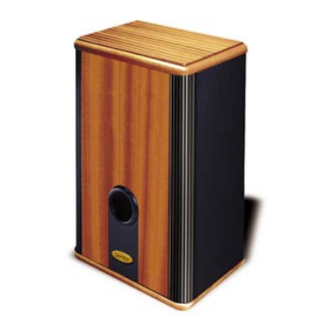
Summary of Contents for Legacy Mist
- Page 2 Registration 3. Owners Record 4. The Cabinetry / Our Commitment Setup 5. Unpacking Your Speakers 6. Speaker Placement / Installation 8. Hook up Cables 10. Amplification 13. Speaker Connections Technology 14. Designer’s Note 16. Specifications...
- Page 3 The model and serial numbers are located on the rear of the unit. Record these numbers in the spaces provided below. Refer to them when calling upon your dealer regarding this product. Model No. _______________________________ Serial No. _______________________________ Date of purchase: _________________________ Thank you for selecting a Legacy Loudspeaker System.
- Page 4 Handcrafted Beneath the surface of MiST’s elegant exterior lies rigid MDF construction. Interlocking joinery maximizes the strength of the cabinet parts. Polyester fiberfill is selected for internal damping. A sharp rap on the enclosure will leave you with little more than bruised knuckles.
- Page 5 V-board corner protectors. Molded foam end caps are used to protect the elegant cabinetry, and a plastic liner is provided as waterproofing. Please save this packing for future transportation. If cartons become damaged or misplaced, new ones can be purchased from Legacy Audio.
- Page 6 A pair of MiST should be wall mounted approximately 6’ high and to the sides of the listener. An optional third MiST may be used as a center rear channel by mounting the unit behind the listener. Because MiST is actually two independent, opposite facing, side-firing arrays in one cabinet, it behaves as a bipolar system.
- Page 7 5. Hang the speaker. WARNING: Woodscrews provided may pull out of sheetrock or wall paneling without a wood brace. They might also pull out of thin speaker panels or perforated particle board. See Figure 2 & Figure 3 for alternate mounting hardware.
- Page 8 The ideal conductor would have negligible resistance, inductance and capacitance. The table below shows how a few actual speaker cables measure up. Cable Ωs/ft pF/ft µH/ft 12 ga. 0.0033 0.21 14 ga. 0.0048 0.13 16 ga. 0.0079 0.18 18 ga. 0.0128 0.21 Capacitance is considered insignificant in each cable because its effect is...
- Page 9 What about phase shift due to frequency dependent travel times down the speaker cable? Measurements show that 100 Hz waves will be delayed about 20 billionths of a second behind 10 kHz waves when traveling to the end of a 10 foot speaker cable. Since the cilia of the ear requires 25,000 times longer than this just to transmit phase information, phase shifting is obviously not the primary concern when considering speaker cables.
- Page 10 Ideally the loudspeaker would be among the first components selected when assembling a playback system. This would allow the user to choose an amplifier capable of delivering adequate amounts of current into the frequency dependent load presented by the loudspeaker. However, when upgrading a system, audiophiles may find themselves matching their new loudspeakers to their existing amplification.
- Page 11 How much power will your new speakers need? That ultimately depends on your listening environment and musical tastes. As little as five watts per channel should drive them to a level satisfactory for background music. A typical 45 watt per channel receiver may fill a room with the compressed mid-band energy of “heavy metal,”...
- Page 12 When an amplifier is unable to fulfill your loudspeakers demands, a damaging harmonic spike may be leaked to the high frequency drivers. Another important point regarding loudness is that the dB scale is a logarithmic one. This means that a 150 Watt amplifier will potentially sound only twice as loud as a 15 Watt amplifier.
- Page 13 At the rear of your MiST you will find a terminal plate housing jumpered pairs of five-way binding posts. Connect the output of the rear channel amplifier to the loudspeaker via the gold five-way binding posts provided. Dual banana plugs or gold spade lugs are recommended means of termination.
- Page 14 Each array consists of a premium quality 5.25” KEVLAR composite driver and a 1” Ferro fluid cooled Titanium tweeter. Unlike most wall mount speakers, MiST is internally equalized for on-wall placement. This results in a very smooth frequency response. Its specialized polar pattern prevents “glare”...
- Page 15 Our research has shown that a controlled directivity quasi-bipolar array can result in a radiation pattern which minimizes such phasiness and provides better continuity in the ambient field. MiST takes advantage of a directivity controlled bipolar array to fill dead spots and prevent near field listener burnout. The polar...
- Page 16 System Type: Configurable 2-way bipolar array. Dimensions: 11” W x 17 3/8” H x 7 1/4” D Crossover Frequencies (Hz): 2.8k Frequency Response: 79-25 kHz +/-3 dB Sensitivity: 90 dB on axis with each array. Impedance: 8 ohms/array, 4 ohms with inputs in parallel (jumpered) Weight: 24 lbs *Dolby Digital and Pro Logic are trademarks of Dolby Laboratories Licensing Corporation.
- Page 17 Notes:...
- Page 18 © 2003 Legacy Audio 150 Locust Street. Macungie, PA 18062 Phone: 610 965 0494 Fax: 610 965 4915...

















Need help?
Do you have a question about the Mist and is the answer not in the manual?
Questions and answers